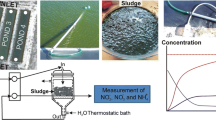Abstract
There is a distinct possibility that the simultaneous sludge digestion and metal leaching (SSDML) process will encounter oxygen limitation, at least for some duration of the process. This is because of the high oxygen requirement, for sulfur oxidation as well as for sludge solids degradation, combined with the low solubility of oxygen. This can alter the system kinetics and downgrade the process performance. The present work focuses on the effect of dissolved oxygen concentration and oxygen transfer rates on the process of sludge acidification. SSDML experiments were carried out in 20 L capacity laboratory reactors as well as a 4000 L capacity pilot plant. It was found that the duration of oxygen limited kinetics is directly proportional to the concentration of biodegradable sludge volatile solids and inversely proportional to the surface area of sulfur and initial concentration of less acidophilic bacteria in the sludge. During this period, the specific growth rates and sulfate production rates of the sulfur oxidizing bacteria are reduced to a fraction of their actual values due to the limitation in oxygen. Based on this information, empirical relations were developed and these were used to simulate oxygen limited SSDML process sequences. The oxygen uptake rate (OUR) and the volumetric oxygen transfer coefficient (kLa) values were calculated for 12 runs carried out in the pilot plant. Increase in kLa obtained by increasing the aeration rates were marginal at higher aeration rates. Also, very high OUR values observed in the complete absence of sulfur oxidizing bacterial activity indicate aerobic digestion to be the predominant oxygen consuming step.
Similar content being viewed by others
References
Dudley, D. J., Guentzel, M. N., Ibarra, M. J., Moore, B. E. and Sagik, B. P.: 1980, Appl. Envir. Microbiol. 39, 118.
Sreekrishnan, T. R., Tyagi, R. D., Blais, J. F. and Campbell, P. G. C.: 1993, Wat. Res. 27, 1641.
Sreekrishnan, T. R., Tyagi, R. D., Blais, J. F., Munier, N. and Campbell, P. G. C.: 1996a, Effect of Sulfur Concentration of Sludge Acidification During the SSDML Process, Water Research 30, p. 2728–2738.
Sreekrishnan, T. R., Tyagi, R. D., Blais, J. F., Munier, N. and Campbell, P. G. C.: 1996b, Modelling the Bacterial Decay Coefficient During the SSDML Process, Journal of Env. Eng., vol. 122.
Standard methods for the examination of water and wastewater: 1989, APHA, AWWA and WPCF, 17th edition. American Public Health Association, Washington, D. C., U.S.A.
Tyagi, R. D., Sreekrishnan, T. R., Campbell, P. G. C. and Blais, J. F.: 1993, Wat. Res. 27, 1653.
Tyagi, R. D., Benmoussa, H. and Campbell, P. G. C.: 1994a, Simultaneous Metal Leaching and Sludge Digestion: Recovery of Sulfur and Air Requirements, Proceedings of the 26th MidAtlantic Industrial Waste Conference, pp. 275–282 (Supplementary volume), Delaware, U.S.A.
Tyagi, R. D., Sreekrrishnan, T. R., Blais, J. F. and Campbell, P. G. C.: 1994b, Wat. Res. 28, 2367.
Author information
Authors and Affiliations
Rights and permissions
About this article
Cite this article
Tyagi, R.D., Sreekrishnan, T.R., Blais, J.F. et al. Effect of Dissolved Oxygen on Sludge Acidification during the SSDML-process. Water, Air, & Soil Pollution 102, 139–155 (1998). https://doi.org/10.1023/A:1004986518555
Issue Date:
DOI: https://doi.org/10.1023/A:1004986518555




